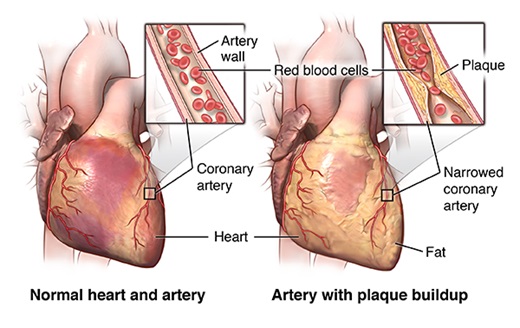Dr. Sanjeev K Khulbey

Coronary artery bypass surgery is one of the most commonly performed major surgery across the globe.
Its also commonly referred to as “Bypass surgery” or “CABG”. It is advised to group of patients suffering from significant narrowing of coronary artery resulting into MI or heart attack.
Due to this surgery, new pathways were created across blocked arteries so that blood can bypass the narrowsegment to provide oxygen and nutrients to heart muscle. These pathways are blood vessels (artery or vein) taken from elsewhere in the body and sutured to diseased heart vessels.
TIMELINE OF CABG
CABG is not a very old surgical procedure. First successful CABG surgery was performed by Dr.
Kolsov in USSR. Later it was popularized by Dr. Renne Favalaro in USA. Since then it has been practiced with multiple modifications every where in the world.
WHO NEEDS CABG SURGERY ?
There are multiple indications which signals that patients can go through CABG. Enumerating these:
1.Patient with significant narrowing of coronary artery at one or multiple portions.
2. Left main coronary artery disease.
3. CAD with anomalous coronary artery disease.
4. Patients with comorbidities like LV dysfunction, COPD, CKD.
5. Multi vessel disease in Diabetics.
6. Failed medical treatment and Failed PTCA stenting.
7. Conditions where PTCA is not possible.
HOW IS CABG DONE AND WHAT IS ON PUMP AND OFF PUMP CABG ?
Conventialy CABG is performed by two methods, OFF PUMP and ON PUMP CABG. This is a major surgery so it requires lot of preparation. After basic cardiac and presurgical tests surgery is planned. The surgery is performed under general anaesthesia. The steps of surgery are as follows
1. Under GA after proper painting and draping the surgeon first make incision over chest to cut Sternum (Breast bone). Heavy battery operated saw is used commonly for cutting sternum. This step is called Median Sternotomy.
2. After sternotomy protective membrane over the heart (Pericardium) is opened and heart and heart vessels are examined.
3. Now conduits for bypass grafting are harvested.Chest wall arteries (Internal mammary artery IMA), hand artery (Radial artery) and leg vein (Saphaneous vein) are commonly used conduits.
4. After preparing all conduits cardiopulmonary bypass (CPB)is initiated. Heart is cooled down and aorta is clamped. Cardioplegia solution is used to stop heart for the ease of surgery.
5. On CPB different conduits were attached beyond the diseased segment of coronary artery. Proximal end of these conduits is attached on ascending aorta.Chest wall artery is harvested in such way that one end is attached naturally with aorta and other end is attached with coronary artery. Using IMA is now standard for all CABGs as long term patency rate after 10 years is more than 95% as compare to saphanoeus vein(50%).
6. After completion of grafting, aortic clamp is removed and heart started beating on its own. After stabilizing the heart CPB is weaned off.
7. After haemostasis, two chest drains in both pleural cavity and RV pacing wire are kept. After the procedure sternum is closed with steel wire. Skin and soft tissue closure is done after that.
8. Once surgery is over patient is shifted to ICU. In the ICU the patient is ventilated for 6 to 8 hrs. Chest drains are usually removed after 48 hrs. Nearly 30 % patient needs blood transfusion during post operative period.
9. Nearly 5 to 8% patient may require reexploration with in first 24 hrs of cardiac surgery. This is mainly because of prolong effect of medicine we use during CPB.
10. Nearly 25% patient develop heart rhythm disturbance (arrythmia) after surgery. Most of these condition are managed completely with medicine.
11. The patient is mobilized from very next day of surgery and gradually go back to his routine. The average length of stay is 7 to 10 days. This duration is further reduced in OFF Pump amd minimal invasive surgery.
OFF PUMP CABG
The operating steps are same as ON Pump CABG. Only difference is exclusion of Cardiopulmonary bypass(CPB). So cardioplegia, aortic cross clamping and use of heart lung machine is totally avoided.
The heart is beating through out the procedure like in any other general surgery. The small area of heart is immobilized with the help of tissue stabilisers and conduits are attached at the desired part of coronary artery. This procedure needs little more expertise.
The immediate outcomes are definitely better as compare to ON pump CABG. Long term of results of both procedures are same.
WHAT IS MINIMAL INVASIVE CABG ?
This is newer version of CABG which is performed with chest wall incisions (Thoracotomy) or with partial sternotomy. Some time Robotic assistance can also be used for IMA harvesting. Special instruments are required for this procedure. This operation has selective indications and can not be performed safely in all patients. The post operative recovery is excellent after this procedure.
HOW THE PATIENT RECOVER AFTER CABG ?
Normally all incisions are closed with absorbable sutures and hence does not require removal. Chest drain stiches are removed nearly 8 to 10 days after surgery. Patient can take normal bath after 5 days of surgery. All patients who have their leg veins harvested should wear stockings while walking or sitting on chair for 4 weeks.
Breast bone take 4 to 6 weeks to unite. Hence patient is advised not to lift heavy weight, avoid driving for the same duration.
Non sternous activities can be resumed as early as possible. The patient can go back to his routine life style gradually with in 4 to 6 weeks. Other important points to adapt are avoid smoking, control weight, control Diabetes, control blood pressure and cholesterol.

WHAT ARE THE RISKS AND COMPLICATIONS OF CABG ?
CABG is very safe operation with mortality less than 1%. Nearly 5 to 8% patients require re-exploration due to excessive bleeding. 1 to 2% patients have stroke after surgery. Some patients can have wound infection and lung complications after surgery. The factors which affect outcome of surgery are poor heart func‐tion, diabetes, left main coronary artery disease, COPD, CKD and advance age with very frail body habitus.
WHAT ARE THE ADVANTAGES OF CABG ?
This is a life saving procedure with maximum long term benefit from symptoms like angina and recurrent heart attack. Majority of current studies suggest that patients are more likely to get benefit from CABG as compared to medical therapy alone.
CABG improves survival in patients with LV dysfunction (poor heart function) and heart failure. CABG also helps in alleviating symptoms and thereby improving quality of life in patients of heart disease
with Diabetes, CKD(Chronic kidney disease)and COPD.
(Writer is Senior Cardiothoracic Surgeon in Apollo Hospital Hyderabad)
Also read: Curious case of Bru Community: Refugees in their own land
 Jubilee Post News & Views
Jubilee Post News & Views





